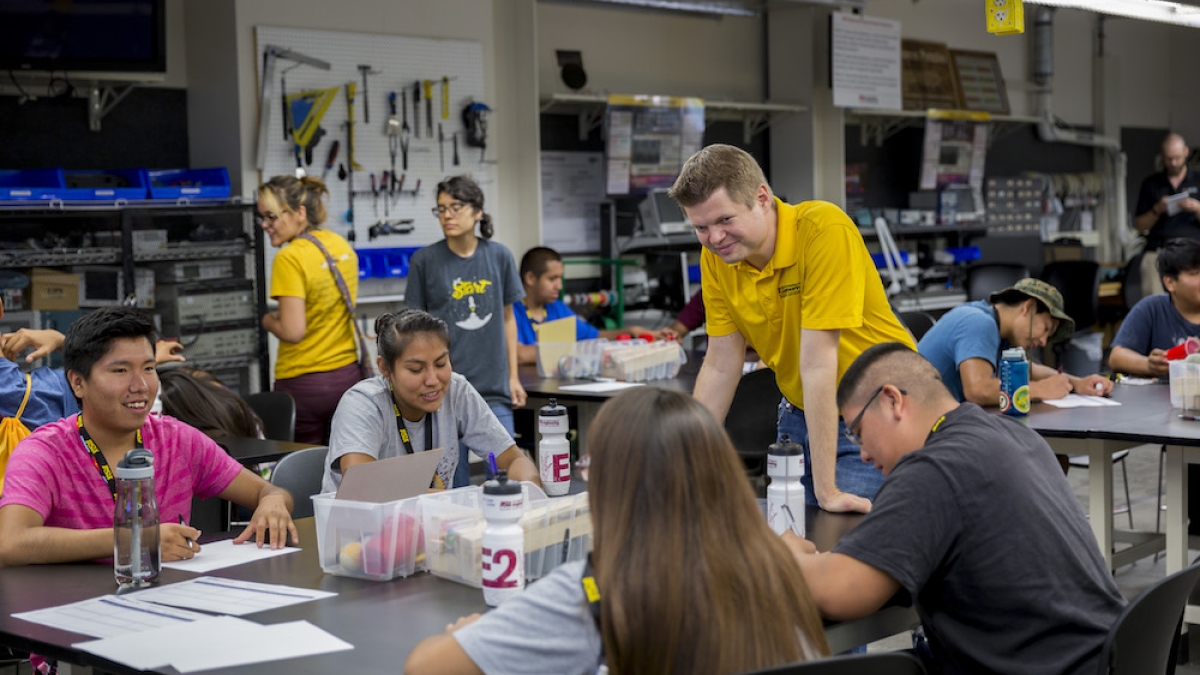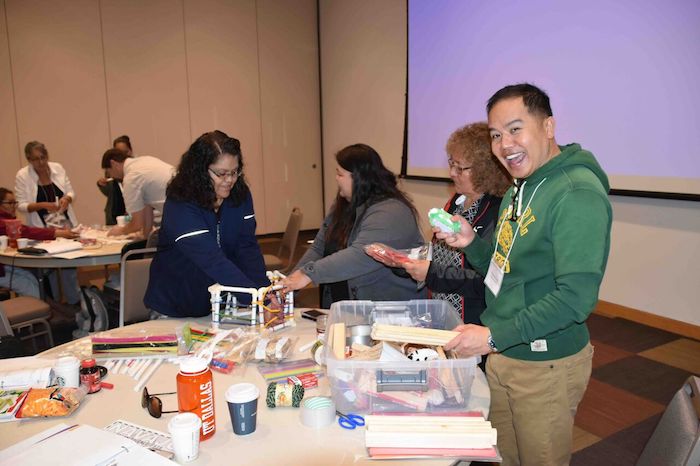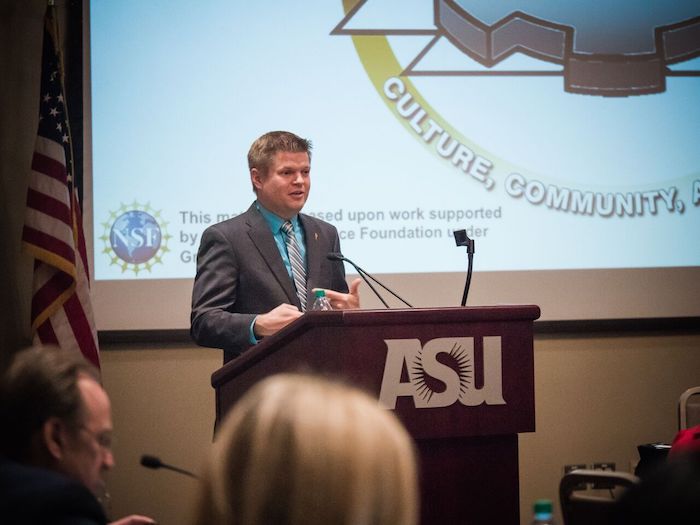Cultural relevance laying foundation for meaningful engineering education
Support from a National Science Foundation CAREER award aids professor's efforts to draw Navajo students to STEM subjects

Shawn Jordan took a risk five years ago with his proposal for a project he hoped would earn one of the most sought-after National Science Foundation awards granted to young academic researchers.
Jordan knew the proposed endeavor to partner with Navajo Nation educators to develop engineering curriculum for their schools would challenge him both as a researcher and educator.
To understand the Navajo culture deeply enough to design effective curriculum “was going to present me with a very large learning curve,” he said. “So that was the risk.”
But based on the knack for innovative approaches Jordan was demonstrating as a young faculty member in Arizona State University’s Ira A. Fulton Schools of Engineering, the NSF decided to throw its support behind his aspirations.
In 2014, Jordan received the NSF Early Career Development (CAREER) Award, which recognizes university faculty members deemed to have the potential to become leading researchers and educators in their areas of expertise.
The award has funded Jordan’s collaboration with STEM (science, technology, engineering and math) education specialists with the Navajo Nation Department of Diné Education’s Office of Diné School Improvement (Diné is what many Navajo people traditionally call themselves) to introduce middle school students to the engineering design process.
The challenge isn’t about bringing conventional approaches to teaching engineering to Diné students. The idea has been to develop culturally relevant ways of instructing youngsters in the fundamental technical and conceptual aspects of engineering while also instilling in them a sense of the rewarding possibilities STEM studies could make happen in their futures.
The goal is also “to teach engineering in a way that each individual discovers and defines for themselves what it means to be both Diné and an engineer,” Jordan said.
“Navajo culture is grounded in Diné epistemology and guided by traditional teachings that influence our societal and environmental values,” said Colin Ben, a citizen of the Navajo Nation and a postdoctoral research scholar in the Fulton Schools and ASU’s School of Social Transformation.
“Navajos evaluate projects and potential partnerships based on how the end product will improve the quality of life for our people, strengthen economic stability and/or enhance educational services for our youth, but only if it is carried out with respect and sensitivity to Diné protocols,” said Ben, who is doing research on Navajo education.
“Culturally, today’s decisions are made with the understanding that it will impact future generations of Navajos,” Ben said. “Therefore, the decisions require high-quality outcomes that will last for a long time.”
Similar thinking guides the Navajos’ outlook on subjects such as natural-resource extraction.
“Land is sacred in the Navajo culture,” Jordan said. “So, if you are using engineering in mining or drilling, even if it’s very efficient and profitable, it can be seen as a horrible travesty if it violates their traditional relationship to the land.”
A group of teachers from the Navajo Nation participate in a hands-on training workshop on culturally relevant engineering curriculum modules in preparation for piloting the modules in their schools. Photo by Shawn Jordan/ASU
Those factors are why designing curriculum for Navajo Nation schools won’t work if it’s based on one-size-fits-all models of education.
Jordan’s NSF project has led to ongoing pilot programs in Navajo middle schools that involve culturally relevant engineering design studies. The programs are showing encouraging results.
Students are demonstrating an understanding of how skills in engineering and other STEM fields can serve the interests of the nation and be pathways to improving the lives of those in their communities.
Jordan said the project is proving the effectiveness of focusing on cultural relevance as a cornerstone of a solid foundation for educational improvement, especially in underserved communities.
“Periodic interventions to improve curriculum are not going to change the paths of education systems,” Jordan said. “We need holistic approaches that establish the connections between what and how students are being taught and the challenges they face in the communities they are living in.”
One of the major outcomes of the project is the work now underway to support Navajo Nation middle schools to become certified as STEM schools. The certification provides schools professional guidance and support to boost the quality of their education programs.
Jordan said results so far are showing educators can bridge cultural divides and bring lessons from each other’s experiences into efforts to improve education.
“I think my research could be used as a model for how to successfully and respectfully carry out research and curriculum development in partnership with cultural or ethnic groups that the researchers and scholars involved are not a part of,” Jordan said.
Jordan is also spending some of his time on sabbatical during the 2018-19 academic year learning new methods he can use to help schools spark students’ interest in STEM subjects.
Through studies at the Storytelling Institute at South Mountain Community College in Phoenix, Jordan will develop a framework for using oral storytelling as a tool for engineering education.
He wants to help engineers and students learn how to craft and tell the stories of their own pathways into the profession.
The approach is contrary yet also complementary to the way engineering education is often marketed by colleges and universities.
“The focus is usually on degree programs and academic disciplines and the skills they give you and the jobs they prepare you for. The focus should instead be more on people who do engineering and the positive impacts they are making in society,” he said. “We can use storytelling to help young students envision a life as an engineer and the impact they can have in their communities.”
Fulton Schools Associate Professor Shawn Jordan gives a presentation about his project, "Career Engineering Design Across Navajo Culture, Community and Society," to a gathering of the Trustees of Arizona State University and ASU President Michael Crow. Jordan is helping to develop engineering curriculum for Navajo Nation middle school students. Photo by Jamie Ell/ASU
Jordan’s work has been gaining interest among his peers.
He has given talks, presentations and workshops at gatherings of the American Indian Science and Engineering Society, the National Indian Education Association, the ASU Office of American Indian Initiatives, at an NSF Engineering Education meeting and at the Innovation Arizona Summit, among other events.
In 2017, Jordan’s contributions to engineering education earned him the NSF Presidential Early Career Award for Scientists and Engineers, which recognizes innovative research and community service leadership in education and community outreach.
From a big-picture viewpoint, Jordan said the Navajo Nation education project is one of many undertakings that could eventually bring different sociological and cultural perspectives into the practice of engineering — and the NSF is trying to encourage that change by supporting efforts to bring diversity into the engineering workforce.
“That would make the engineering profession more inclusive,” Jordan said, “which in the end will make for better engineering.”
Shawn Jordan shares credit for his progress on the Engineering Design Across Navajo Culture, Community and Society research project with the ASU students and staff members who have been on his research team in recent years:
- Christina Foster, who earned an undergraduate degree in biomedical engineering and a doctoral degree in engineering education at ASU.
- Ieshya Anderson, who is Tohono O’odham and Navajo, and a doctoral student in the Fulton Schools’ Engineering Education Systems and Design program.
- Courtney Betoney, who recently earned an undergraduate degree in mechanical systems engineering at ASU and is now working for Raytheon.
- Tyrine Pangan, who recently earned an undergraduate degree in software engineering at ASU and will pursue a doctoral degree in engineering education.
- Project manager Jay Fernandez, who earned an undergraduate degree in electrical systems engineering at ASU.
Top photo: Shawn Jordan (standing) has directed a series of STEAM Machines programs that integrate science, technology, engineering, art and mathematics by applying concepts from each of those disciplines to the design and construction of chain-reaction machines. Jordan is pictured working with students in ASU’s INSPIRE program for American Indian high school students. Photo by Jessica Hochreiter/ASU
More Science and technology

Making magic happen: Engineering and designing theme parks
The themed entertainment industry is widespread and diverse, encompassing everything from theme parks to aquariums, zoos, water parks, museums and more. The Theme Park Engineering and Design…

AI-equipped feeders allow ASU Online students to study bird behavior remotely
ASU Online students are participating in a research opportunity that's for the birds — literally. Online Bird Buddies is a project that allows students to observe birds remotely, using bird feeders…

National Humanities Center renews partnership with Lincoln Center for responsible AI research
The National Humanities Center has announced that Arizona State University's Lincoln Center for Applied Ethics is one of four organizations to receive funding for the second phase of their…

